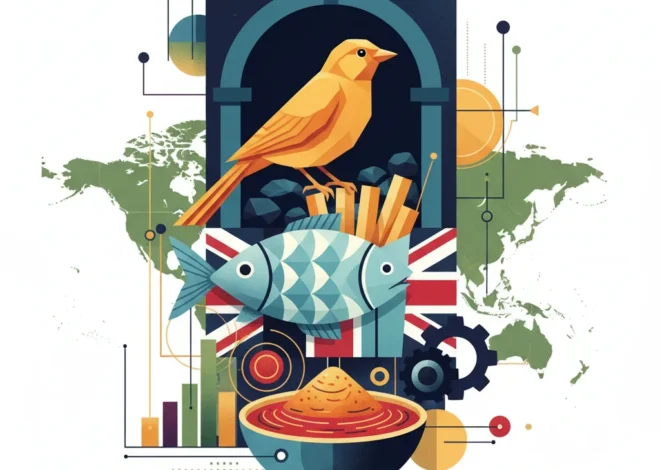
From the Fields to the Financial Markets: Why a Farmer’s Budget Plea Matters to Every Investor
In the quiet expanse of the British countryside, far from the frantic energy of the stock market trading floor, a crucial economic conversation is taking place. It’s a conversation that begins in the soil but sends ripples through the entire UK economy, touching everything from banking and investing to the future of financial technology. Ben Aveling, a farmer, recently voiced concerns that serve as a powerful microcosm of the broader challenges facing businesses today. His call for the government to scrap planned inheritance tax changes and lower interest rates isn’t just about agriculture; it’s a bellwether for the economic pressures that define our current landscape. As reported by the BBC, these requests ahead of the UK Budget highlight a critical intersection of legacy, capital, and national economic policy.
For investors, finance professionals, and business leaders, dismissing this as a niche sectoral issue would be a mistake. The challenges of succession planning, the burden of high borrowing costs, and the need for a supportive fiscal environment are universal. By deconstructing this farmer’s plea, we can uncover profound insights into the state of the UK economy, the delicate balance of monetary policy, and the future of investment in foundational industries.
The Inheritance Tax Conundrum: Protecting Legacy or Hindering Growth?
At the heart of Mr. Aveling’s first request is the complex and often emotionally charged topic of Inheritance Tax (IHT). In the UK, IHT is a tax on the estate (the property, money, and possessions) of someone who has died. For many family-run businesses, especially capital-intensive ones like farms, IHT can pose an existential threat.
To mitigate this, the government has long offered Agricultural Property Relief (APR). This relief can reduce the market value of agricultural property by up to 100% when it’s being transferred, effectively shielding working farms from being broken up or sold to pay a hefty tax bill. This policy acknowledges that the value of a farm is tied up in illiquid assets—land and machinery—and its primary purpose is food production, not just asset speculation.
The concern stems from potential changes to this relief. Speculation has been rife that the government might restrict APR, for instance, by removing it for tenanted farmland or for land used for non-agricultural purposes like environmental schemes. Such a change would fundamentally alter the economics of farm succession and land management.
Below is a simplified overview of the current IHT structure and the potential impact of APR.
| Scenario | Standard IHT Calculation | Calculation with 100% APR |
|---|---|---|
| Value of Agricultural Estate | £2,000,000 | £2,000,000 |
| IHT Nil-Rate Band | – £325,000 | N/A |
| Taxable Value | £1,675,000 | £0 (Value reduced by 100%) |
| Estimated IHT Due (at 40%) | £670,000 | £0 |
Note: This is a simplified illustration. Actual calculations can be more complex, involving other reliefs and exemptions. For official guidance, refer to the UK government’s website.
For the broader business community, this is a critical case study in succession planning. The potential removal of such reliefs forces business owners to reconsider their strategies, potentially leading to premature sales, increased debt to cover tax liabilities, or a fragmentation of assets that undermines long-term viability. It impacts the banking sector, which finances these transitions, and the investment landscape, as it could alter land values and availability.
Beyond the Glitter: Decoding Investment Signals in the Shifting Jewellery Market
The Macro-Economic Squeeze: Interest Rates and the Cost of Capital
The second pillar of the farmer’s appeal—a call for lower interest rates—moves the discussion from fiscal to monetary policy. Like many businesses, farms rely heavily on credit to finance everything from new equipment and land acquisition to managing seasonal cash flow. When the Bank of England raises its base rate to combat inflation, the cost of this borrowing skyrockets.
Over the past two years, businesses across all sectors have felt the strain of a rapid tightening cycle. The Bank of England’s base rate surged from a historic low of 0.1% in late 2021 to a 15-year high of 5.25% by August 2023, where it has remained. This aggressive hiking campaign was a necessary, if painful, medicine to curb rampant inflation. However, the side effects are significant:
- Increased Debt Servicing Costs: Businesses with variable-rate loans have seen their interest payments multiply, squeezing profit margins and diverting capital from growth and investment.
- Deterrent to New Investment: The high cost of capital makes new projects and expansions less financially viable. A farmer considering a multi-million-pound investment in new technology or infrastructure must now clear a much higher profitability hurdle.
- Impact on Asset Values: Higher interest rates can put downward pressure on asset prices, including land, as the return on less risky assets (like government bonds) becomes more attractive.
This directly influences the stock market and broader investing strategies. Companies with high debt levels become riskier propositions, while sectors sensitive to consumer spending (which is dampened by higher mortgage rates) may underperform. The call for lower rates is a plea for an economic environment that fosters investment and growth over contraction and caution.
Agriculture’s Convergence with Modern Finance and Technology
While the immediate concerns are traditional, the solutions and the future of the agricultural sector are increasingly intertwined with modern finance, data, and technology. This is where the conversation expands to include fintech, blockchain, and new models of trading and investment.
The challenges of capital access and risk management in farming are ripe for disruption by financial technology. We are already seeing:
- Fintech Lending: Alternative lending platforms are emerging that use advanced data analytics—from satellite imagery of crop yields to real-time market prices—to underwrite loans for farmers more efficiently than traditional banks.
- Parametric Insurance: Insurtech companies offer products that pay out automatically based on predefined triggers (e.g., rainfall below a certain level), reducing paperwork and providing faster liquidity after adverse weather events.
- Supply Chain Finance: Blockchain technology offers the potential for immutable, transparent records of produce from farm to fork. This not only enhances food safety but also creates new opportunities for finance. A shipment of produce, verified on a blockchain, can be used as collateral for a loan while it’s still in transit.
This technological shift changes the very nature of agricultural assets. A farm is no longer just land and buildings; it’s a data-generating enterprise. This data has immense value, influencing everything from its creditworthiness to its potential for participating in new markets, such as carbon credit trading.
The Paradox of India's Growth: Why a Booming Economy is Begging for a Spending Spree
For investors, this convergence opens up new asset classes and opportunities. Investing in ag-tech (agricultural technology) is no longer a niche; it’s a central part of a sustainable and technology-driven future. The economics of a single farm are now connected to global data networks, sophisticated financial instruments, and the rapidly evolving world of fintech.
Conclusion: The Budget’s Ripple Effect from Field to Finance
Ben Aveling’s call for government support is more than one man’s request; it is a reflection of the fundamental economic forces shaping our time. The debate over inheritance tax is a debate about the future of family businesses and the intergenerational transfer of wealth. The pressure from high interest rates is a universal challenge affecting capital allocation and investment decisions across the entire economy.
The government’s response in the upcoming Budget will send a powerful signal. Will it prioritize the stability of foundational industries through targeted reliefs, or will it focus on broader, macro-level fiscal consolidation? Will its policies create an environment that encourages the adoption of financial technology and innovation, or will it inadvertently stifle it?
For anyone involved in finance, investing, or business leadership, the story that starts in a farmer’s field provides a clear and compelling lens through which to view the critical economic questions of today. The answers will not only determine the future of our farms but will also shape the landscape of banking, investment, and the stock market for years to come.
Beyond the Dial: Deconstructing the Luxury Watch as a Financial Asset
Ultimately, a healthy agricultural sector is a cornerstone of a resilient national economy. Supporting it is not just about sentiment; it’s about strategic economic management. The decisions made in Westminster will have a direct impact on the cost of capital, the flow of investment, and the ability of businesses—large and small, rural and urban—to thrive in an increasingly complex world.


